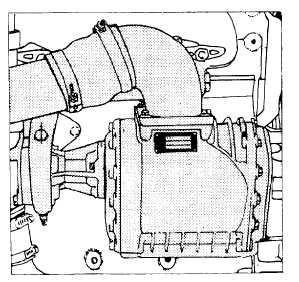Inspect blower rotor lobes for smoothness. Inspect rotor shaft serrations and bearing surfaces for wear or burrs.
Check the finished faces of the end plates to see that they are smooth and flat.
Check the finished ends of the blower housing, which receive the end plates, to see that they are flat and free from burrs. The end plates must set flat against the blower housing.
Check blower timing gears for wear or damage. If either timing gear is worn or damaged sufficiently to require replacement both gears must be replaced as a set
Inspect the inside of the housing to see that the surfaces are smooth. The blower drive shaft should be straight and true. Shaft serrations should be clean and straight. You should replace all worn or excessively damaged blower parts.
After you have cleaned and inspected all the blower parts, reassemble the blower as prescribed in the manufacturer's maintenance and service manuals.
SUPERCHARGERS
A diesel engine may be equipped with a supercharger (fig. 5-37). The supercharger is a gear-driven air pump that uses rotors to force air into the engine cylinders when a requirement for more power exists. The supercharger must be maintained periodicaly.

Figure 5-37.-Supercharger.
Remove the outlet connection of the suprcharger and visually check the ends of the rotors and case for evidence of oil leaking from the supercharger seals. Rotors will always show some oil from the vapor tube, which is connected to a rocker housing cover. However, only the appearance of wet oil at tie ends of the rotors would be cause for changing the seals of the supercharger. Be sure to check the lubricating oil lines and connections for any leaks. Correct these conditions if needed.
Removal
When the supercharger has to be removed from the engine, follow the procedures given in the manufacturer's service manual.
Disassembly
If you have to disassemble the supercharger, be careful when you remove the intake and discharge connections. Be sure to cover both openings. To prevent damage to its finished surfaces, usually made from aluminum, wash the outside of the supercharger with mineral spirits. Use the correct service tools and follow recommended disassembly procedures in the manufacturer's maintenance and repair manuals.
Cleaning and Inspecting
As the supercharger parts are disassembled, you should clean and dry them thoroughly with filtered compressed air. Discard all used gaskets, oil seals, recessed washers, roller bearings, and ball bearings. Replace these parts with new ones.
Inspect the rotors, housing, and end plates for cracks, abrasions, wear spots, and buildup of foreign material. With a fine emery cloth, smooth all worn spots found. Discard cracked, broken, or damaged parts. Remember, rotors and shafts we not separable. They must be replaced as a matched set or unit.
Inspect the drive coupling for worn pins, distorted or displaced rubber bushings, and damaged or worn internal splines. Examine the hub surface under the oil seal and replace the coupling if its surface is grooved or worn.
Check the gear fit on the rotor shafts and the gear teeth for evidence of chatter and wear. Replace the rotors and gears if they are not within the required tolerances.
Inspect all dowels, oil plungers, piston ring seals, and gasket surfaces. Replace them as necessary.
Continue Reading